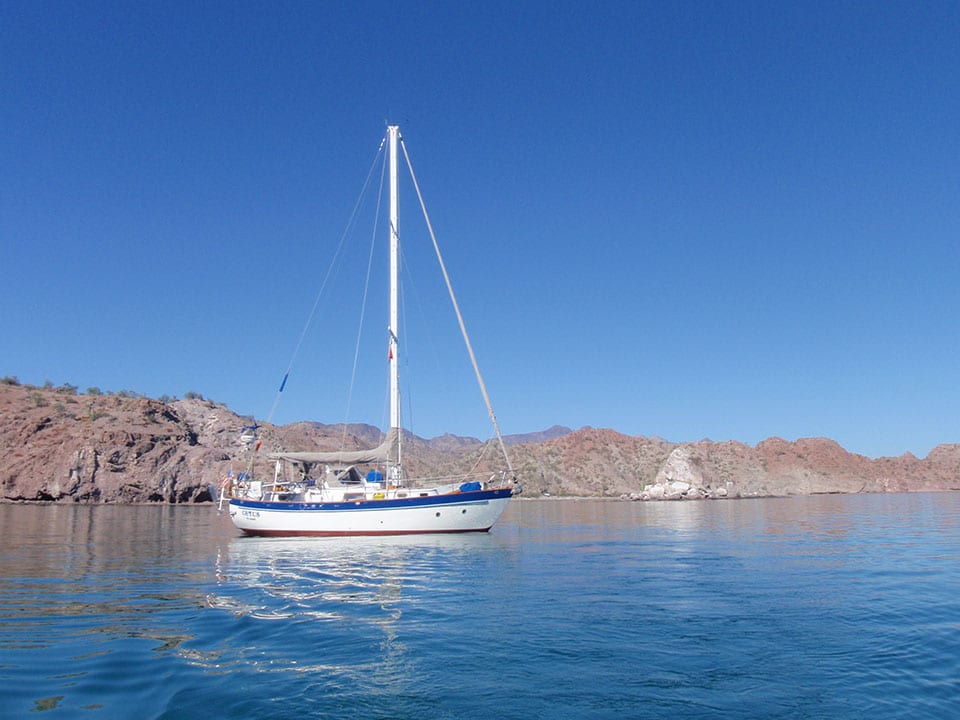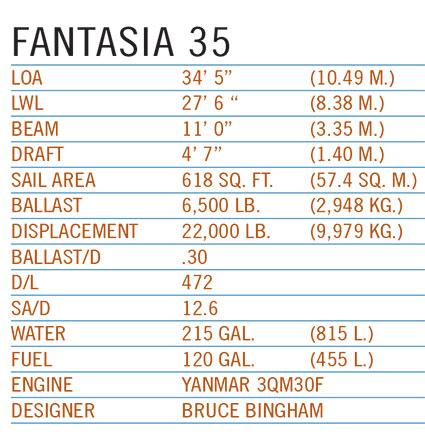
Fantasia 35
Once you know that Bruce Bingham drew the lines of the Flicka—a full-keeled, 20-foot sprite with the interior space of boats several feet longer—it makes sense that he also penned the Fantasia 35. This capable cruiser, with its portly hull and distinctive round portlights, boasts 7 feet of headroom and a layout that owners of many 40-footers would envy.
A center cockpit in a boat this size is a rare but brilliant approach that allows for a three-cabin layout. The aft cabin has a portside double berth. It’s accessed through a stand-up passage on the starboard side that doubles as the head, while the same space on the port side contains a workshop with standing headroom and lots of storage.
In the main cabin, the galley resides along the starboard hull, and an L-shaped dinette is to port. A split V-berth and plenty of storage take up most of the forward cabin. This ambitious interior layout, a pleasing mix of comfort and practicality, works well. The woodwork and cabinetry are typical of Taiwanese boats of the era: teak bulkheads with vertical staving and arched cabin doors. For its size, the Fantasia carries astounding quantities of water and diesel. The auxiliary is beneath the cockpit and accessible on three sides.
Topside, the cozy center cockpit is perched high, elevated by the generous freeboard of the canoe-stern hull. The decks are narrow alongside the cabin, and the sail plan is pure sloop, although a staysail stay was an option. Early Fantasias had heavy wooden masts and booms, but later models were delivered with much lighter aluminum spars.
Aspects of the Fantasia’s sailing characteristics could be attributed to its history. Adventure Yachts commissioned the design from Bingham in the early 1970s. The two parties had their differences, and Bingham wasn’t pleased when he saw the prototype in 1975. Changes were made, and the first 50 boats delivered were fine offshore cruising yachts but had pronounced weather helm. Many owners lived with it, but others, to improve handling, made changes that included adding a bowsprit to shift sail area forward and the addition of a skeg aft of the rudder.
On hull number 51 onward (78 were built in total), the rudder was moved to a skeg about 4 feet aft of the full keel, and the steering was switched from hydraulic to mechanical. This Mark II, as it became known, was much better balanced when under way.
Many owners have replaced the original black-iron fuel tanks and the raw water-cooled Yanmars. Potential buyers should take note that some chainplates weren’t secured as designed. The original icebox insulation leaves a lot to be desired. Teak decks installed on a few boats may be prone to leaks.
Several of these sturdy little ships, including both Mark Is and Mark IIs, have cruised extensively. The owners of hull number 61 and hull number 71 report that the Fantasia’s best point of sail is a broad reach in 15 to 25 knots. The boat tends to yaw dead downwind and doesn’t point well. Because the Fantasia is a heavy-displacement cruising boat, prospective owners should consider a good inventory of light-air sails.
|

|
Asking prices begin at about $35,000 and rise to $65,000 for nicer examples of the Mark II. For someone looking for a lot of room in a small, robust package, the Fantasia is an affordable option.








